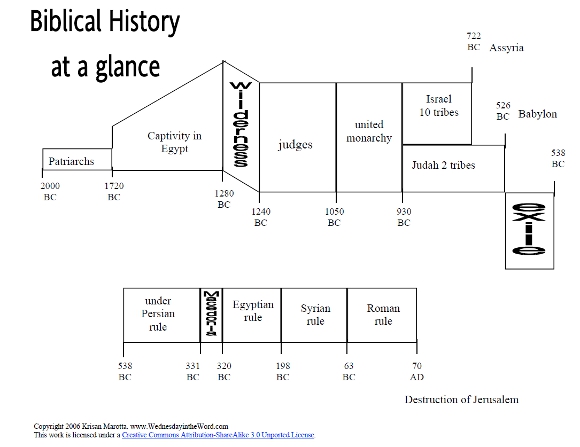Overview of Biblical History: Whenever you study Scripture, it’s important to know where your particular passage fits into biblical history.
As Karl Barth said: “The Bible is not a philosophical book, but a history book, the book of God’s mighty acts, in which God becomes knowable to us.”
Here’s a simple overview of biblical history. All dates are approximate (and many are debated), except for 4 dates which are reliably fixed in history:
- 772 BC – the northern kingdom conquered by Assyria
- 586 BC – the southern kingdom conquered by Babylon
- 538 BC – Cyrus ends the exile
- 70 AD – Rome conquers Jerusalem
The dating scheme below follows traditional dating.

Downloadable PDF of the Chart
Primeval History
Books: Genesis 1-11; Job
Main events: Creation, fall, Cain & Abel, Noah and the flood, and the Tower of Babel.
2000 BC – Patriarchs
Books: Genesis 12-50
The history of the nation of Israel starts with God calling Abram/Abraham. This one man led to one family, which led finally to 12 large tribes. Abraham was promised a land, a people and a blessing in Genesis 12. The rest of the Old Testament shows how God worked out those promises. Main characters: Abraham, Isaac & Joseph.
1720-1280 BC – Captivity & Exodus
Books: Exodus
Through the story of Joseph, the descendants of Abraham end up as slaves in Egypt which eventually leads to God bringing them out of slavery through Moses & the Exodus. There is some debate about the exact date of the Exodus.
1280-1240 BC – Wilderness
Books: Exodus, Leviticus, Numbers, Deuteronomy
The Exodus leads to the wilderness period where the children of Israel are wandering in the Sinai desert which culminates with the giving of the law at Mount Sinai.
1240 – 1050 BC – Conquest & Judges
Books: Joshua, Judges, Ruth
The wilderness period ends with the conquest of the promised land. The conquest begins with crossing the Jordan River (c. 1240). The conquest of the promised land is followed by the period of the Judges. Israel lives in the land under the theocracy of God. The people turn away from God and God disciplines them by handing them over to their enemies. When they return to God, God raises up a judge to deliver them. But then the cycle repeats in a downward spiral. After the 12th judge, Israel demands a king like all the other nations.
1050-930 BC – United Monarchy
Books: 1&2 Samuel; 1&2Chronicles; Psalms of David
In response to the demands of the people, God gives the nation a king: first, Saul, then David and Solomon. The period of the monarchy or united kingdom also has its ups and downs, but overall it is Israel’s glory days of peace and prosperity.
- Saul’s reign c. 1038-1010 BC; 1 Samuel 8-31; 1Chronicles 10.
- David’s lifetime c. 1040 -970 BC; ruler over Judah c. 1010 BC; ruler over Israel c. 1003 BC; 2 Samuel; 1Chronicles 11-29; 1Kings 1:1-2-11.
- Solomon’s reign 970 -930 BC; 1Kings 1-12; 2Chronicles 1-9.
930-586 BC – Divided monarchy
Books: 1Kings12-2Kings 17; 2Chronicles 1-38; Proverbs, Ecclesiastes, Song of Solomon, Obadiah, Joel, Jonah, Hosea, Amos, Isaiah, Micah, Nahum, Zephaniah, Jeremiah, Habakkuk.
After the death of Solomon in 930 BC, civil war breaks out over who should inherit the throne. The kingdom splits with 10 tribes forming the northern alliance with a capital in Samaria; and the two southern tribes of Benjamin and Judah forming a separate alliance with the capital remaining Jerusalem.
- Northern Kingdom: Israel (930-722 BC)
- Southern Kingdom: Judah (930-586 BC); 2Kings 18-25; 2Chronicles 28-36.
Introduction to the Northern Kingdom
Introduction to the Southern Kingdom
586-538 BC – Exile & Captivity
Books: Ezekiel, Daniel, Lamentations
Around 740 BC the Assyrian empire became the superpower of their day. A series of powerful Assyrian kings held the Syria-Palestine region in their grip, exacting yearly tribute on pain of swift revenge for any rebellion. In 722 BC, Israel rebelled (again) and the Assyrians conquered her capital city, ending her existence as a nation and taking the 10 northern tribes into exile.
Eventually the Babylonians defeat Assyria and become the dominant world power. They conquer Jerusalem in 586 BC, destroying the city, burning the temple and deporting the children of Israel.
538 -400 BC – Return & Restoration
Books: Ezra, Nehemiah, Esther, Haggai, Zechariah, Malachi
The prophets predicted that this captivity would end and the people would be return to their land. In three stages, over about a hundred years, they were allowed to migrate back to Jerusalem, rebuild the city and rebuild the temple.
Introduction to the Exile and Return
The Old Testament closes with the people back in their land as a vassal state of Persia, awaiting the Messiah. The end of Malachi marks the beginning of 400 years of prophetic silence broken by John the Baptist.
Further Study
Introduction to the Intertestamental Period
New Testament History from Alexander to Titus
Josiah Blake Tidewell: The Bible by period (1916)
Frank Palmer: A Bird’s Eye View of the Bible (1914)
Ray Stedman’s Adventuring through the Bible (1997)
Ray Stedman’s Panorma of the Scriptures
John MacArthur Bible Introductions
John Edgar McFadyen: Introduction to the Old Testament (1905)
Henry Drummond: Introduction to the New Testament (1915)
Photo by Douglas Williams on Unsplash

